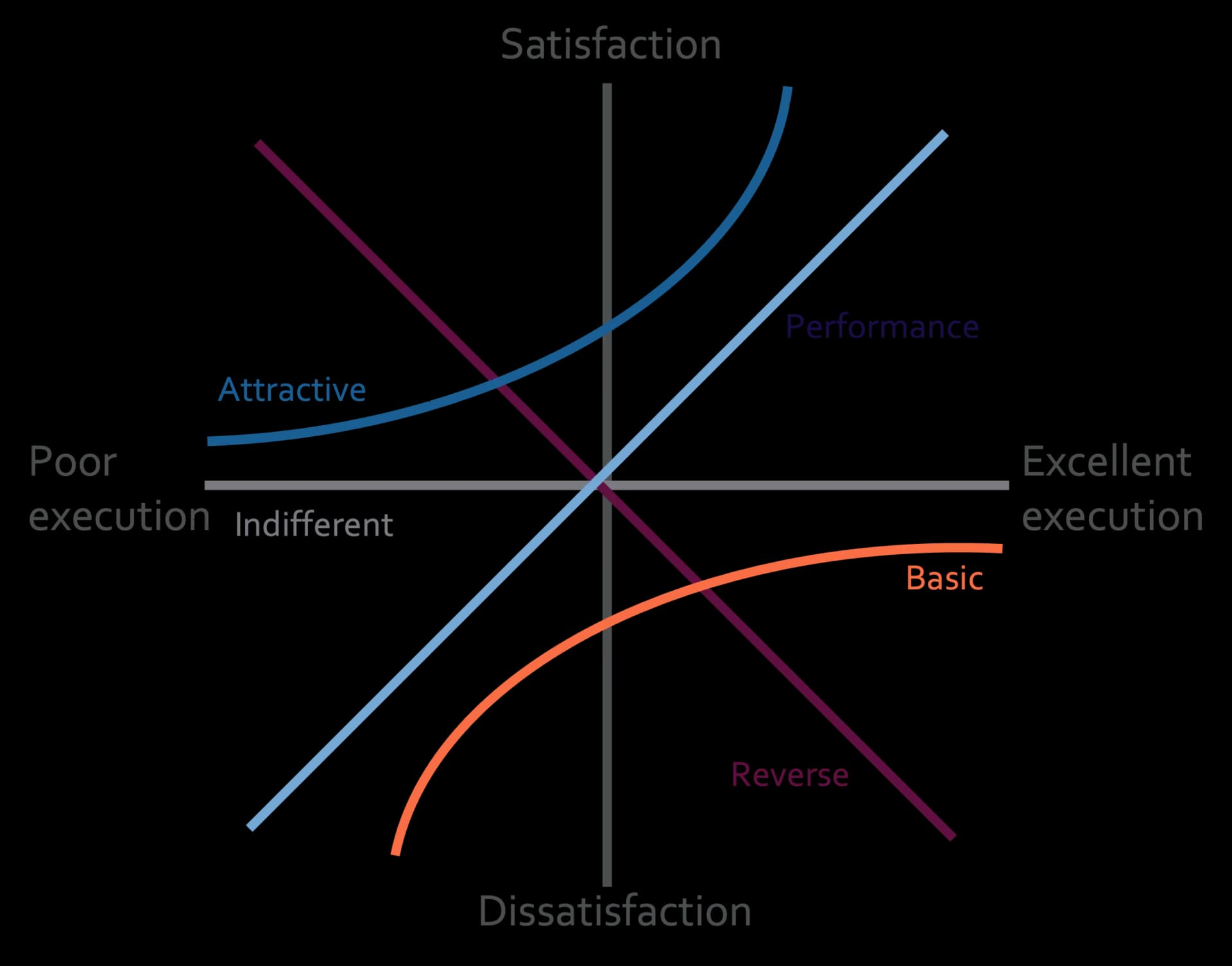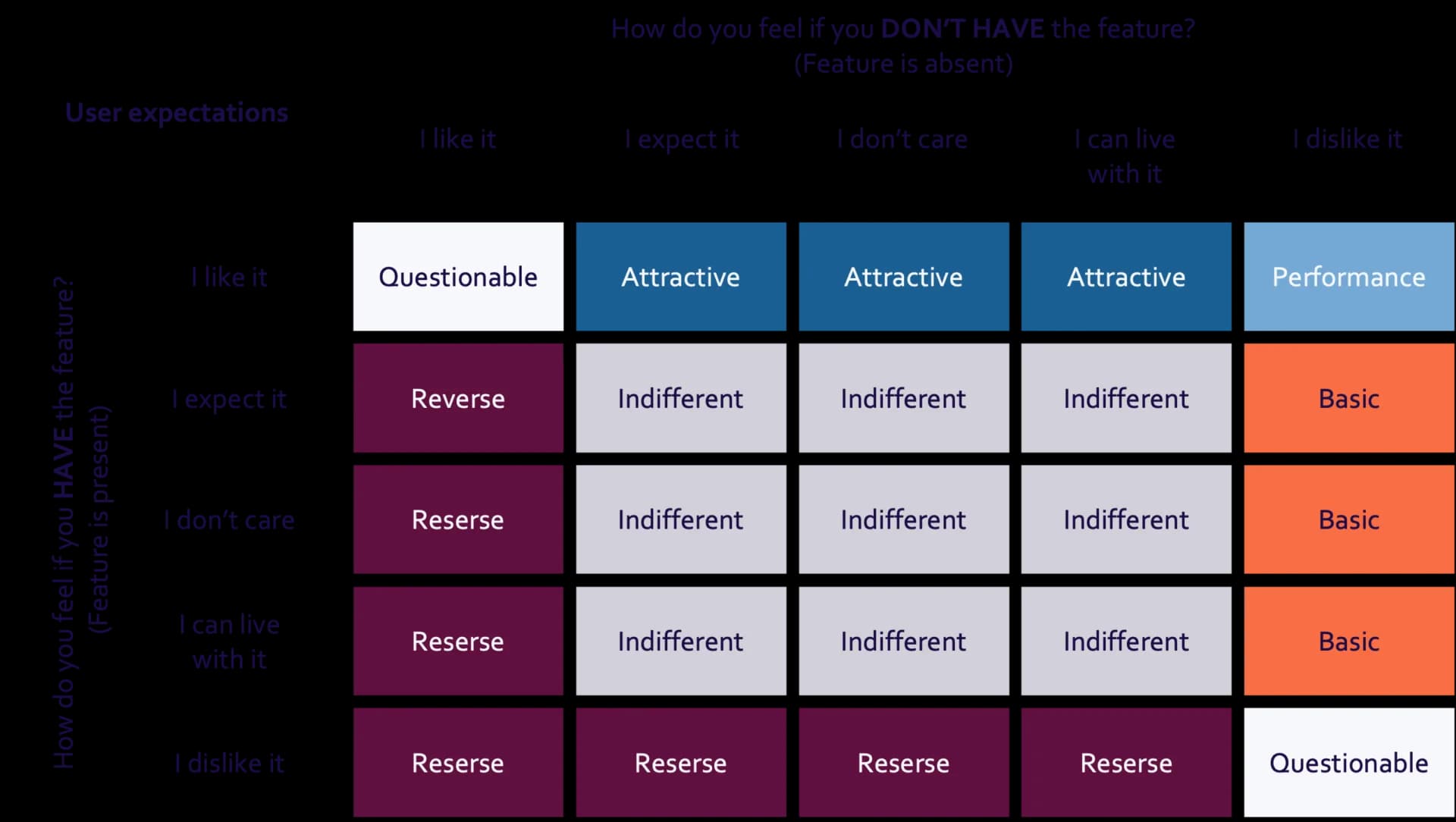Why prioritize?
Prioritization methods and techniques raise awareness among product people (a combined term for product managers and product owners) in the product management community, as well as project, program and portfolio managers, about some of the best prioritization methods, their main features, pros and cons, and the most suitable use cases for each method. Comparing prioritization methods based on specific criteria helps decision-makers determine in which situation a given prioritization technique can be most effective.
Before diving into the first prioritization method - the Kano model - it is important to explain the need to prioritize and what the main challenge with prioritization is.

Why is prioritization important?
Prioritization is the process of ranking or ordering a set of items in order of importance. The product backlog, being one of the key artifacts in agile-based frameworks such as Scrum, must be constantly prioritized to capture the items with the most value on top.[1] In a scaled environment it is essentially the same – (enabler) features on the program backlog and (business and enabler) epics on a portfolio backlog must regularly be prioritized.
But why is prioritization necessary? In many cases, demand is higher than supply or available capacity. From a product management point of view, product managers and product owners must prioritize their backlog items because they do not have unlimited resources and time. In reality, it is not feasible to have an unlimited number of skilled and capable people who can deliver results immediately. That is why prioritization is a key skill for success.
Main challenge with prioritization
The main challenge with prioritization is deciding what is most important. As Don Reinertsen put it: “The main problem with any prioritization decision is [the] decision to service one job and delay another.”[2] People should understand that doing one thing means delaying other things.
A conversation with a project lead in a high-tech company highlighted this challenge when discussing the priority of features on a project. When asked to define the priority of his features, he said “I want everything!” While it may be tempting to label all features with “Priority 1,” “high” or “urgent” priority, caution is needed. If everything is urgent, then everything loses its urgency. If everything is important, then nothing is really that important.
There is also a recognizable antipattern of trying to please all stakeholders by starting with one big unprioritized list with all the items you have or are given to you. This indecisive behavior causes several problems:
- Lack of direction and focus: Pleasing everyone means pleasing no one. We need to have a mission to pursue. Once we try to please everyone, we will run in different directions, team members will lose focus, and this will inevitably have disastrous consequences
- Welcome Frankenstein: a mix of everything which has no shared goal will lead to a product that nobody understands and wants
Popular prioritization methods and techniques
How can we define the priority of any type of work, whether prioritizing epics, features, stories, tasks, etc.? There is always the option of simply relying on a gut feeling when deciding the importance of a feature, user story or a task. However, this is far from desirable, as it puts the entire project at risk. A better approach is to use a proven prioritization method or technique.
There are many prioritization methods and techniques available. Based on experience and what has worked well for companies, the following five methods and models are covered in a series of six articles:
- Kano model - in the scope of this first article
- MoSCoW method
- Eisenhower matrix
- Value vs Effort matrix
- Weighted Shortest Job First (WSJF)
- Comparison of some of the best prioritization methods - comparing the five methods discussed in the previous articles
The focus now turns to the Kano model, the prioritization method in the scope of this first article.
Kano model
The Kano model was created by the Japanese researcher Professor Noriaki Kano in 1984.
The Kano model, also known as Kano analysis, is a customer-driven prioritization method used by many product people to determine priorities. The model describes a qualitative relationship between product attributes or features and the degree of customer satisfaction or dissatisfaction that they engender.[3] The technique is used to classify customer preferences or requirements into five different categories:
- Basic: These are “must-be requirements” customers expect and are taken for granted. They must always be present. Having all these basic requirements does very little to increase customer satisfaction and most often customers are just neutral. But if these requirements are not present, customers are very dissatisfied. As a result, another name sometimes used for this category is “dissatisfiers.”[4] Examples of features in this category include the possibility to change your personal account password on a website, cleanliness of the carpet in a hotel room, or voice calling functionality in a smartphone
- Performance: Features in this category generate satisfaction the better they perform and generate dissatisfaction when their performance is poor. They are the most visible of the Kano requirements and are the easiest to acquire because customers talk about them all the time. As a result, features in this category are also often called “satisfiers.” Prof. Kano originally called these requirements “one-dimensional” because they are linear in nature. More is better here and will result in a more valuable overall product.[4] Examples include the battery life of a mobile phone (the longer a mobile phone battery lasts the better), the resolution of a new TV screen, or the range of electric cars
- Attractive (also called Excitement): Features that are not expected, but when present cause a pleasant surprise or delight. The lack of these items does not cause user dissatisfaction because they are not expected but can increase overall satisfaction with a product. Prof. Kano originally called these requirements “attractive” or “delighters” to associate them with their real nature. Some companies call them unique selling propositions (USPs) since these are innovations that make your offering unique.[4] Examples of excitement or attractive requirements include a complimentary Belgian chocolate bar in your hotel room left by the hotel staff, or a voice-activated parking-assist system when you want to park your car in a tight space
- Indifferent: Features that make us feel indifferent if implemented. Most customers simply don’t care about whether these requirements are present or absent, their satisfaction remains neutral anyway and, in many cases, it is not worth implementing them or developing the functionality further.[4] An example can be some of the advanced functionalities on a smartphone that almost no one would ever use. If these are expensive to include or support, the logical step is to eliminate them
- Reverse: Even though this category is often overlooked, it has its benefits. The absence of the features in this category can cause satisfaction, while their presence will cause dissatisfaction (for most people). These features could frustrate customers, so you should avoid building them further or completely exclude them from your offering.[4] An example could be Instagram’s decision to remove the 'Following' tab from their app, which allowed people to see their friends’ likes and comments. The reasoning behind this decision is because the functionality caused a lot of controversies, such as claims it was making many users paranoid and depressed

Figure 1: Dimensions and categories in the Kano model
The horizontal axis represents the degree of execution or fulfillment. On the right extreme, items are fully executed (excellent execution and the need is well fulfilled), whereas on the left extreme, items are executed very poorly or not implemented at all and hence the need is not fulfilled. The vertical axis is the satisfaction level for a particular requirement or feature – on the top, customers are very satisfied or delighted and, on the bottom, customers are dissatisfied or even disgusted.
Kano questionnaire
After inputting the dimensions and the categories of requirements in this model, a special survey or questionnaire can be designed and used to determine which Kano category your requirements or features fall into. The Kano survey is the most time-consuming part when using this prioritization model, as you need to approach your users (to get real customer feedback) and ask the following two questions for each feature you would like to evaluate:
- “How do you feel if you have the feature?” (this is our functional question)
- “How do you feel if you don’t have the feature?” (this is our dysfunctional question)
The questions are not open-ended and require specific answers. The answers were not designed to offer a specific rating, but rather to provide a sense of customer expectation towards each feature. Possible answers include [5]:
- I like it
- I expect it
- I don’t care (i.e. I am neutral)
- I can live with it (i.e. I can tolerate it)
- I dislike it
Evaluation of results
Based on the answers to the functional and dysfunctional questions from the Kano survey, the following Kano matrix (see Table 1 below) is used to evaluate the results and assess each feature. The table shows in which of the five categories each feature belongs (Basic, Performance, Attractive or Excitement, Indifferent or Reverse). There are two cells with questionable answers, which contradict each other, and therefore a feature cannot be graded in this case.[5]

Table 1: Kano matrix to evaluate results from the Kano survey
After mapping each feature to the right category, prioritization of the features on the backlog becomes a lot easier. The recommended decision-making process to define the priorities is as follows:
- Basic features – these features are must-be and should always be implemented first (e.g. when launching a new product)
- Attractive or Excitement and Performance features – these are not must-be requirements, but if you want your customers to be satisfied, these features should be implemented as well. “Attractive” features are equally important as the “basic” requirements since they differentiate your offering from your competitors and give customers a reason to select your offering when they have many other choices. “Excitement” features justify higher margins because customers are willing to pay extra for new features or functionalities that add value. It is important to note that time has a big influence on the “excitement” features. What is exciting for customers today (“excitement” features) will be asked for tomorrow (will transition into “performance” features) and will be expected as a “basic” requirement the day after. An example is what is happening with smartphone cameras. Take Samsung, for example. In 2020 they launched phones with 64 MP telephoto zoom camera and even a model with 108 MP wide-angle camera. If users are happy with the performance of these cameras, this requirement can quickly become a “performance” feature and can even be transformed into a “basic” requirement in the future
- Indifferent features – in most cases it is not worth doing these due to no appreciation on the investment (no sufficient return on investment). These features should be moved to the bottom of the backlog
- Reverse features – don’t implement these features due to customer dissatisfaction if present and negative impact on the product. The advice is to remove these features from the backlog (or if they are already implemented, consider getting rid of them)
The first three Kano categories – Basic, Performance, and Attractive or Excitement – are all critical to the success and future profits of your offering.
Let’s now look at the advantages and disadvantages of the Kano model.
Pros of the Kano model
- Highlighting the potential strengths and weaknesses of a product. One of the most valuable aspects of the Kano model is user feedback. The results from the Kano questionnaire or survey help to identify the future product’s strong and weak points. This allows product people to know the product or market fit early in development. Understanding how the list of requirements fits into the Kano model can also help an agile team determine which of the requirements or features to include, which need enhancement, which need cost reduction, which simply leave as are, and which should just be excluded
- Prioritizing product features based on their real value for customers. The Kano model is a very customer-driven prioritization scheme. It relies on direct communication and feedback from the customers or users. It helps rate the product attributes from the value proposition standpoint and tailor them to perfectly match user needs
- Envisioning the right product to build. When creating a new product, it is important to have a good product vision. The Kano model allows you to capture the right requirements based on direct user feedback and allows you to establish a clear vision on what product to build based on a good mix of basic, performance and excitement functionality
Cons of the Kano model
- Restricted by customers’ opinion and knowledge. The Kano model is a very customer-centric model which intends to bring customer satisfaction, however, it still has pitfalls. A backlog prioritized using the Kano model may introduce a plain wishlist (even though items are ordered based on the different categories) and be limited to expectations of customers who have no technical background. There is no indication on technical feasibility and implementation. To make Kano really efficient, product people have to discuss the technical concepts with the engineers or developers separately to ensure what customers want is actually feasible
- Provides no details on required resources (time and cost). Although the Kano model gives a more comprehensive picture on how to establish the priorities from the customer point of view, it does not account for time and costs that are necessary for the implementation of a particular feature
- Time-consuming practice. Since the Kano survey, which may target a lot of potential customers, is incorporated in the Kano model, the effort to process and evaluate the final results might be quite significant. It could slow down the whole time-to-market process and distract the team from execution of the work
- Contradictions in translation and number of categories in the model. The language of the original publication of the Kano model was Japanese. From the very beginning, some of the translation of the key terms in English has been misleading and the names of the categories have been translated in different ways by different parties, which means that they may have different names depending on who you are speaking to and which version of the category names they learned. Moreover, Prof. Kano identified five different categories of product features based on client perception (as described in his original article), however, many publications and discussions on the Kano model focus on only three or four of those categories. This article describes all five categories of the model and highlights the possible names that can be used interchangeably for each category
When to use the Kano model
The Kano model is very useful for companies in the early stages of their development, for example, startups striving to generate user feedback for the initial UX design of their product. Submitting their concept in tandem with the results from the Kano survey (prioritizing the features into the different categories) would be efficient and would help distill a lot of value. However, if your product entails technical complexity and various hidden blockers, the Kano model should either be used together with other prioritization techniques or even be completely replaced by other more sophisticated prioritization schemes.
For more information about prioritizing using the Kano model, please feel free to contact us.
References:
[1] Schwaber, K., & Sutherland, J. (2017). The Scrum Guide: The Definitive Guide to Scrum: The Rules of the Game. Retrieved from 2017-Scrum-Guide-US.pdf
[2] Burns, M., Reinertsen, D., Matts, C., Arnold, J., Grout, T., Magennis, T. (2016) Better Backlog Prioritization (from random to lifetime cost of delay). Everyday Lean. Retrieved from Better-Backlog-Prioritization-v0.2.pdf
[3] Kano, N. (1984). Attractive quality and must-be quality. Hinshitsu (Quality, The Journal of Japanese Society for Quality Control), 14, 39-48.
[4] Verduyn, D. (2014). Discovering the Kano Model. Retrieved from kanomodel.com
[5] Kano+ (n.d.). The Kano model. Assessing Product Features based on Customer Satisfaction. Retrieved from https://kano.plus/about-kano
Related insights
